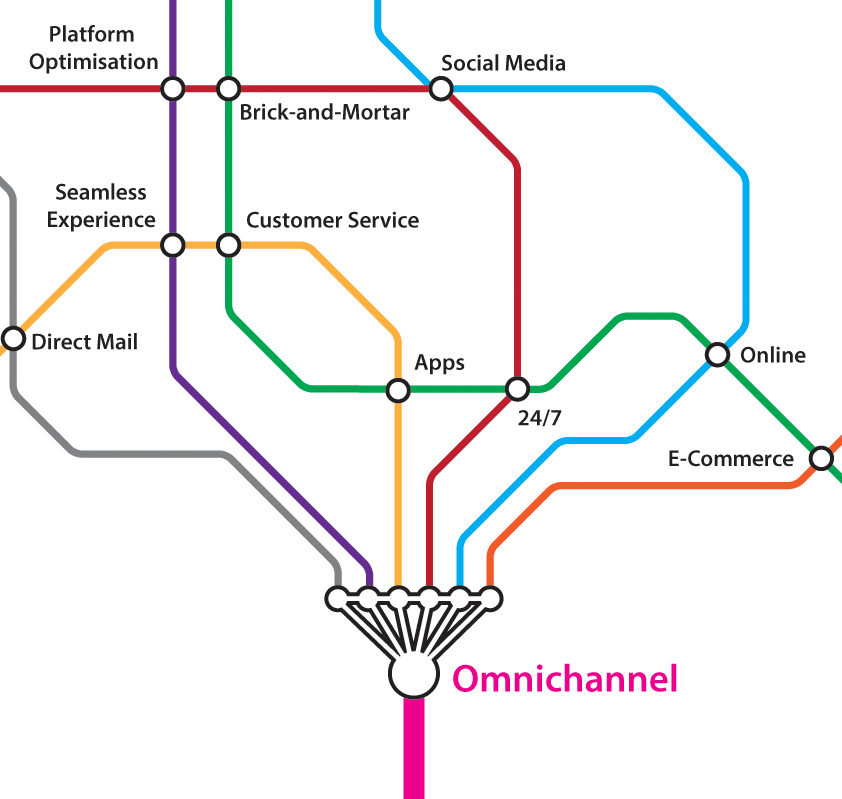 By Kurt Marko
By Kurt Marko
Business is being reshaped by mobile, social, cloud, and big data, and so are customer expectations. Retailing, financial services, communications, travel, and customer service and technical support are feeling the effects most. They are all industries with particularly high customer engagement.
Everything from client devices and applications to IT infrastructure and applications have altered how people learn about, evaluate, and buy things. That includes how they share opinions about products, retailers, and service providers and how they expect to access documents and support.
Interactions spanning multiple platforms and communication channels in the physical and online worlds are known as “the omnichannel customer experience.” As that concept has caught on in business, it has become a reaction to, as well as a driver of, heightened consumer expectations.
Omnichannel originated as a marketing and sales strategy popularized by retailers that sought to provide seamless online and in-store shopping experiences. Today, the omnichannel imperative isn’t limited to retail, nor does it end with a purchase. Consumers expect a consistent, smooth, and unified experience throughout the customer experience lifecycle.
It is challenging, to say the least, to stitch together seams between a consumer’s experience browsing, researching, evaluating, buying, using, sharing, supporting, repairing, and upgrading a product or service. But inexpensive storage and sophisticated data analytics paired with predictive algorithms can turn vast quantities of previously unusable data into useful, actionable information for the company that serves such consumers. Another advantage is the power and convenience of cloud services, which can deliver big data analytics at scale without expensive up-front capital costs. Omnichannel customer service is no longer just a pipe dream.
 Traditional multichannel customer engagement and interaction forced the consumer into siloed sales experiences via specific mediums, including online/web, phone, or in-person. That approach was fine when customers started and finished a transaction or interaction in a single channel. In today’s mobile, hyperconnected world, however, people multitask and interact with multiple devices over multiple channels to complete a task. They might initiate a conversation over either the web, email, social network, text message, or voice, and complete it later on another one of those channels.
Traditional multichannel customer engagement and interaction forced the consumer into siloed sales experiences via specific mediums, including online/web, phone, or in-person. That approach was fine when customers started and finished a transaction or interaction in a single channel. In today’s mobile, hyperconnected world, however, people multitask and interact with multiple devices over multiple channels to complete a task. They might initiate a conversation over either the web, email, social network, text message, or voice, and complete it later on another one of those channels.
To maximize the value and effectiveness of such connection points a business needs to provide customers one digital channel—a consistent experience that spans devices and screens. A customer who begins interacting with the business on one channel should be able to resume the interaction at another time or on another device. And the channel must anticipate what the customer wants to do next. For example, when someone calls your help desk, your agents should know if the customer has been searching your online knowledge base about a particular problem. As in retail, omnichannel customer support is seamless, but it’s also smart, proactive, and anticipatory.
Mobile, multi-platform shopping can result in sub-optimal customer experiences. Some of the most common problems for customers and challenges for businesses include:
- Inconsistencies: As customers move between channels, they encounter unsynchronized information presented in different ways.
- Impersonal interactions: Consumers expect their digital experience to be customized. A brand should know their preferences, learn their habits, and keep track of them regardless of platform. That requires recording when and where a customer performs a particular action and applying context and past history to improve the experience creatively.
- Frustrating customer support: Everyone has suffered through product support calls in which each agent they’re transferred to asks the same questions. Omnichannel transactions can amplify such frustrating experiences, leading customers to give up. Good customer experiences increase loyalty, which reduces cost and increases revenue, according to a recent Forrester study.
- No sense of community, nor leverage of social networks: Social must be woven into the entire lifecycle of a customer relationship. People expect the customer experience to be a two-way conversation. A disjointed omnichannel experience, particularly one without a compelling mobile presence, makes building a community of loyal, engaged customers a virtual impossibility.
Addressing these omnichannel challenges requires more than coating your website and mobile apps with a common UI design; it requires a multi-pronged, data-management strategy using one consolidated repository. This big data problem requires a company to capture and analyze 100 percent of a customer’s interaction data: everything from web transactions and online chat logs to CRM records and contact center transcripts.
Not only must omnichannel analytics ingest and use data from all contact points. It should also support customer interaction using the same channels. If a customer initiates a support question via a mobile text message, they sure don’t want an email response. A stellar omnichannel experience hinges on sophisticated software to analyze transactions, track customer journeys across sessions and channels, and work with multiple output channels. Such software born of significant R&D efforts and intellectual property is beyond the scope of what most companies can build in-house.
Omnichannel platforms are typically delivered best via a SaaS product because of the economies a cloud architecture offers. Many IT departments, however, want the comfort of managing their own data and don’t want to redesign their data-collection processes. SaaS products should offer hybrid models in which bulk data can be stored locally and securely packaged and transported for analysis and decision making.
Delivering a good omnichannel customer experience requires comprehensive data collection across channels (big data), scalable predictive analytics software with adaptive algorithms that manages the customer across channels, support for all common communication channels, real-time decision support, and hybrid cloud delivery with on-premise data repositories feeding cloud-based SaaS applications.
As Forrester’s Ron Rogowksi blogs, “Companies need to focus on delivering great experiences, day in and day out, with products and services that meet customer needs, are easy to use, and are enjoyable.” Are you ready?
Kurt Marko is a technology writer, an independent IT consultant, and editor-at-large for InformationWeek and Network Computing.
![]()
















